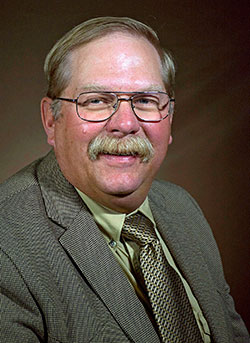UW Professor Chosen to Present at National Cattle Industry Workshop
Published June 03, 2021

A University of Wyoming agricultural economics professor is one of nine presenters at a workshop called by the Committee on Agriculture in the U.S. House of Representatives to analyze cattle market issues, particularly related to price discovery.
Chris Bastian, a UW professor of agriculture and applied economics, will present “How Markets Work,” which will examine price discovery, during the June 3-4 conference in Kansas City. The event is offered by the Agricultural and Food Policy Center (AFPC) at Texas A&M University.
Bastian’s presentation is from a research article, titled “How Market Institutions, Risks and Agent Incentives Affect Price Discovery: Fed Cattle Market Implications.” It was written with Chian Jones Ritten, an associate professor, and Amy Nagler, an assistant research scientist, both in the College of Agriculture and Natural Resources.
The AFPC commissioned papers on specific industry topics from experts around the country. The papers and other workshop information will be submitted in a report to Congress at the end of the summer, and a book, published from the presented papers, will be available to the public.
A conference focus is whether there should be intervention in fed cattle markets.
The UW researchers, instead of policy intervention, support the use of a transparent electronic trading platform for spot market transactions to improve price discovery in fed cattle markets, which would use a double auction, such as that used in futures markets.
“We extend that suggestion here as an alternative for consideration to policies focused on mandating increased negotiated cash trade,” they wrote in their paper. “Research suggests that a double auction would likely be the best trading institution for such an endeavor.”
For markets, one policy fix being proposed would require packers to buy more cattle on a cash basis, which some argue would raise prices.
“If you don’t understand more in-depth some of these risks and incentives, and some of the stuff that’s going on in the market, you can look at that and think that’s probably a really good idea to mandate packers have to buy more cattle on the cash market,” Bastian says. “But, if you understand the risks and incentives both buyers and sellers face in this market, our work suggests that that’s really likely not going to fix all those problems.”
The UW research suggests some buyers and sellers would be better off; and some would be worse off, but supply and demand are largely determining general price levels.
“And these policy proposals are not going to fix the problems they think they are going to fix,” he says.
COVID-19 complicated two major factors that increased concerns in the market, Bastian says. Many worry the use of alternative marketing agreements reduces the volume of reported cash trades to the point reported cash prices do not reflect the true price of cattle.
“So, producers are concerned those negotiated agreements may not be using the right cash price as a base price, and that’s where this concern over price discovery is coming from,” he says.
Packing plant closures were another factor. A fire shut down a packing plant last year, resulting in less demand for cattle and depressing prices for cattle until other plants purchased more cattle or increased capacity.
COVID-19 illnesses among workers then shut down some plants periodically, further reducing demand for cattle.
That resulted in less boxed beef sold to grocery stores and pushed beef prices up in stores. This caused a divergence of prices where beef prices went up in stores, but the prices packers were paying for live cattle went down.
“There was this impression that packers were really just making a ton of money off of live cattle and forcing cattle prices down, and really there were some supply and demand things going on that explain why those prices went that way,” Bastian says.
The reduced cattle demand drove down prices, he says.
Bastian believes there is nothing illegal happening -- not something producers may want to hear, and understandably so, he adds.
“There are real concerns out there, and I understand why they have concerns,” Bastian says. “The problem is this is a very complex economic problem, and the simple fix that’s being talked about really isn’t going to address all of the risks and incentives that are creating these issues.”
For information about the conference, go to https://agrilifetoday.tamu.edu/2021/04/23/agricultural-and-food-policy-center-at-texas-am-to-host-vital-cattle-industry-workshop/.

